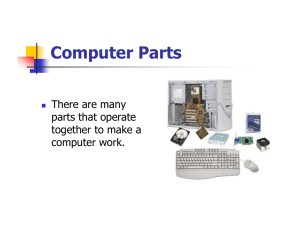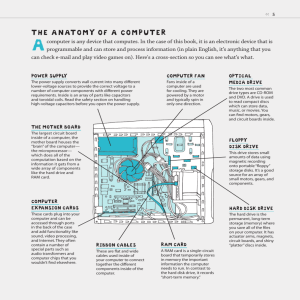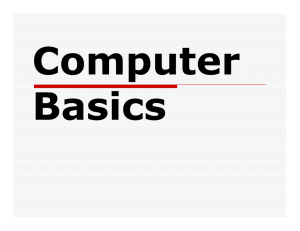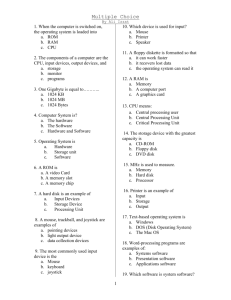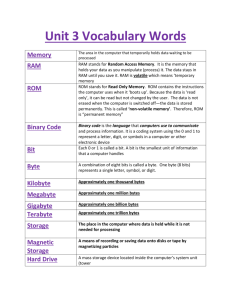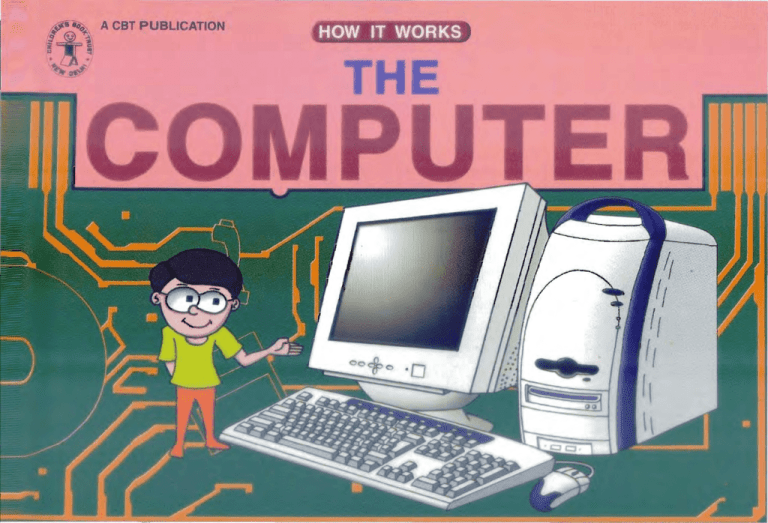
A CST PUBLICATION
OW IT WORKS
By Rakesh Mohan Hallen
Designed and illustrated by
Ankur Mitra
Children's Book Trust,
ew Delhi
,,~::
lP'1:""
.
••
• '.
- ':,
•
~
-
._,,=".., .v
-':"
-.. 1 "
,
.'
-.. _
'._~
-~
-.1
.<
101010101010101010101010101010101010101010101010101010101010101010101010101
They have started invading our life.
They are almost everywhere, offices,
banks, railway stations, post offices,
schools, colleges ... our homes! They are
called computers. Just as the inventions of
the train and the motor car revolutionized
the way we travel from one place to
another, computers have revolutionized the
way we remember, write or communicate.
Not only do they help us to draft a letter,
a report or a book, but also to send it
anywhere even without using any paper!
They can like a radio or television also
be used to share our thoughts, our
emotions, our creations with many people,
all at once.
i
c
?
A computer is an information-processing
machine, an electronic device,
manufactured in a factory, that can perform
many functions-till now done by humans
only. It can see, listen, read, write, speak,
show, learn, remember, think, analyse and
decide. In short, it can communicate
intelligently. It can do so not only with
humans but also with other computers.
It needs electricity from the main power line
to be alive. Without electricity, a computer is
a dead body. If a computer is connected to
a UPS (Uninterrupted Power Supply) or
a battery, it can work for a short duration
even when there is no electricity.
Just as our body has many organs, each
of which has a particular function, the body
of a computer is also made up of several
parts. Like our brain that controls other
parts of our body, in a computer there is
a device called a microprocessor that
allows it to take decisions and control its
101010101010101010101010101010101010101010101010101010101010101010101
I
I I I I I I I I I I I I I I I I I I I I I I I I I I
various parts. We have memory to
retain information and ways to do various
tasks, so has a computer. We have a
face, a mouth and limbs to express
ourselves, a computer has a screen Gust
like that of a TV) that acts like its face,
a device called mouse is like its limb which
can also write, draw and paint, and a small
loudspeaker that enables it to speak or
sing. We have eyes, ears, nose and
skin to help us know our environment.
Similarly, a computer has an operating
system through which you can instruct it to
perform various tasks. Some computers
can also hear voices, see objects and
sense touch through
a microphone, a camera
and a touch screen.
I I
There are several types of computers
Palmtop, Laptop, Desktop, Server,
Mainframe and Supercomputer. A Palmtop
is the smallest and looks like an overgrown
calculator. It can be held in one's palm.
A Laptop looks like a large book that can
be kept on your lap while you work on it
and can accompany you anywhere. Both
a Laptop and a Palmtop work by using the
, 101010101010101010101010101010101010101010101010101010101010101010101
101010101010101010101010101010101010101010101010101010101010101010101010101
c=.
P
stored electricity from a battery. But the
computers we come across most often
belong to the family Desktop (nickname
PC). A Desktop has a relatively large
body and is usually made up of four
detachable parts: one part looks like
a small TV and is called a 'monitor'; the
second part resembles the keyboard of
a typewriter and is called 'keyboard'; the
third, looks like a trendy box, called the
'Central Processing Unit' (or just CPU); and
the fourth looks like a mouse and is called
the 'mouse'. A number ot other devices,
known as computer peripherals like, web
camera, speaker, microphone and printer,
often accompany it like faithful assistants.
They enable it to see, hear, speak, or
deliver desired results. Servers, Mainframes
and Supercomputers are the heavyweight
members of the family. We seldom come
across them, but they are very important
as they manage many PCs, keeping them
connected and in touch with each other.
-
•
GUI and Mouse
The ancestors of the present generation
of computers, born in about 1920, did little
more than a few rather hefty calculations.
Obviously, they were not very popular.
Leaders in the computer industry, like the
IBM (International Business Machines)
executives, felt that they could sell at best
a few thousand computers worldwide. After
all, how many people would be interested
in investing a fortune just to calculate
faster! Besides, these computers could
occupy a big air-conditioned hall and
consume a lot of electricity. People could
1010101010101010101010101010 0101010 01010101010101010101010101010101
I I
I
I
I
interact with them only through a pack of
punched cards. Often it took a few hours
before one got a printed output (there were
no screens to see it). It is only after the birth
of the PC, which has evolved in the last two
decades, that the computers have become
common and versatile. The punched card,
or even the keyboard, is no more essential
for people to interact with a computer.
A user friendly Graphic User Interface
(popularly known as GUI) and a pointing
device (like the mouse) have made
interaction much more effortless and easy.
When the first PC came into being, the
screen of the monitor invariably used to be
black and often blank to begin with. One
was then required to remember and type
in, very accurately, the commands for
various jobs. Definitely, most people found
it inconvenient. But not any more. Today as
one switches on one's PC, one is
welcomed by a colourful graphic display
on the monitor. In fact, most often one can
I
I I I
I
choose the picture. On the picture, there
are some icons with a brief title. This
display is known as the GUI. Moreover,
in order to do a particular task on the PC,
one does not need to type in a command,
just a click of the mouse button is
~
sufficient.
A mouse is a small plastic encased
device, which can be used to control the
position of the pointer, called the cursor,
on the monitor by rolling it on a smooth
surface or a mouse pad. Positioning the
cursor on to a particular icon, or a title
in a list, and clicking the button on the
mouse is a sufficient command to open the
required file.
. 101010101010101010101010101010101010101010101010101010101010101010101
I I I I I I I I 101010101010101 101010101 10101 101 I I
The most enigmatic part of a computer is
the CPU, or the brain of the computer. It is
made up of many ICs (Integrated Circuits),
and other kinds of components that are
found in computers only.
A microprocessor is the central control
area of the computer. It is a microscopic
circuit of a silicon chip and is made up of
silicon, aluminium or copper and plastic.
It contains thousands of electronic devices
known as transistors on a thin slice of
silicon only about six millimetres square in
size! It has many electronic switches inside
it that helps it to do its task by stopping or
allowing the electric current through
them. A transistor is the basic unit of each
such switch. It is through selective
switching 'on' and 'off' of transistors that
a microprocessor acts as the brain of
a computer. A microprocessor used In the
present generation of computers (say
a P-4 computer) is made up of as many as
I I
ten million transistors, each connected to
many others through microscopic lines of
aluminium that act as wires. The last few
generations of PCs are known by the
name of the microprocessor like 386, 486,
Pentium, Celeron, Xeon, Athlon, Cyrix.
One feature that distinguishes one kind
of microprocessor from another is the
'clock speed', a built-in clock, that sets the
pace for all activities inside it. The clock
speed is measured in cycles per second
11I1I1I1I1II1111111
Integrated Circuit
ICs are an essential component of any
electronic device. An IC often looks like a small
piece of plastic with many metallic legs. Inside
an IC, there is a complex electronic circuit made
up of different kinds of electronic componentstransistors, resistors and capacitors. They are all
connected to each other through extremely thin
lines of copper and are engraved on a tiny chip
of silicon.
I
1 1 I I 1 1 I I 101 I 1 101 I
(a unit also called the Hertz or Hz). You will
come across words like MHz or GHz in the
advertisements for computers in newspapers and magazines. The clock speed
of the latest brand of microprocessors is
above a billion Hertz.
There are several kinds of memory: the
basic memory, the short-term memory and
the long-term memory in a computer like
in our brain. Although we do not have
a unit that measures the memory of our
brain, we do have a unit for the memory of
a computer. It is known as byte.
101010101010101010101010101010101010101010101010101010101010101010101
101010101010101010101010101010101010101010101010101010101010101010101010101
The smallest unit of the memory of
a computer is a bit (an acronym for binary
digit). A bit is a single transistor device in
a computer, which is akin to a light bulb.
It has only two possible states, 'on' (often
indicated by the numeral 1) or 'off'
(indicated by 0). To store or convey more
information, bits are organized into larger
units called bytes-the commonly used
unit of information in a computer. Each byte
contains 8 bits and can represent only
a single character or command. A brief
letter to your friend may require just a few
thousand bytes, whereas to store
a postcard size colour photograph, it may
require several million bytes.
The terms, KB (kilobytes), MB
(megabytes) or GB (gigabytes) one often
comes across in advertisements for
computers, are more convenient units. Just
as a businessman finds it convenient to talk
In terms of lakhs and crores, computer
I
I
I
o
users often say one MB rather than the
1024 kilobytes or one GB instead of saying
one billion bytes. K stands for kilo or
thousand. To be exact K stands for 1024
bytes. Very soon, when you grow up a bit,
you will encounter the term TB (Terabytes,
that is, a trillion bytes) too.
Corresponding to the various kinds of
memory in our brain, computers have
ROM (the basic memory), RAM (short-term
memory) and the Disk Drive (long-term
memory).
Off
On
Off
o
1
o
Character
Off
0
Byte
On
Off
1
0
On
1
Character
-
-
01000001
01000010
01000011
01000100
o
Byte
(8 bits)
A
B
C
0
Off
(8 bits)
0
1
2
3
-
00000000
00000001
01000010
00000011
I I
Our memory is responsible for the very
basic functions of our body like breathing,
eating, drinking or moving our limbs.
Similarly, the CPU of a computer has
a chip-an integrated circuit, known as the
ROM (Read-Only Memory). It does not
fade easily, just like our basic memory.
Even when the electric supply to
a computer is switched off, it does not
forget. Like the microprocessor, it is also
made up of a particular kind of transistor.
ROM stores the basic functions
a computer has to follow as it is switched
on. It also stores all the information about
the other parts present in the computer.
Therefore, it is the memory that
a computer uses to check up whether all
the parts are present or not. It raises
an alarm in case something is amiss.
I
I I
I
I
When we sit for an examination in school,
we often cram up many facts so that we
can remember them rapidly when we need
them. We often forget these facts and
instructions once the examination is over.
The part of our brain that we use for this
purpose is known as the short-term
memory. The CPU also has a short-term
memory. It is called RAM (Random Access
Memory). RAM is also in the form of ICs
that are made up of transistors.
Nowadays, a PC usually has more than
128 MB RAM. In sharp contrast to the
ROM, RAM is a temporary memory. As
soon as a computer is switched off or its
power supply is disrupted, it forgets all the
information in its RAM.
I 10101010101010101010101010 010101010101
010
0101010101010 0101
101 I I I I I I I I I I I I 101 I I I
0"
As we age, we get to remember many
facts and instructions. The part of our brain
that stores all such memories is the longterm memory. A computer has a variety of
memory devices. The most significant one
is the Hard Disk Drive (HDD). It is often the
most voluminous memory of a computer.
Unlike ROM or RAM, it is not an IC chip.
An HDD comes as a factory-sealed unit
that is made up of several aluminium (or
glass ceramic) disks, called platters. Each
of these platters has a coating of a thin film
of a magnetic material, like the tape of an
audio or video cassette. The memory of an
HDD is divided into concentric circles on its
platters called tracks. A read/write head
attached to a movable arm reads
information from or writes information on
these platters. The platters are rotated at a
very high speed with the help of an electric
motor and the read/write heads move from
the rim towards the centre of the platter. This
I 101
I I I
I 0
Magnified inner view of an HDD
way information can be read from, or written
on almost any part of an HDD in a jiffy.
It can store a lot of information including
programs and data. By the end of the last
century, the capacity of an HDD installed
in a common PC had risen up to several
GB, this is sufficient to remember text
typed on several crore pages or an equal
number of photographs or sounds.
It continues to rise further almost every
month. Unlike the RAM, but somewhat like
ROM, the information stored in an HDD is
not volatile, that is, it will not forget the data
stored in it if the power supply is
disconnected. An HDD can be
transplanted from one computer to another
with all the information stored in it.
101010101 101
o 0101010101
10101 101010101
I I
We often need to transfer or distribute
information. Until recently, paper was the
only medium for this purpose, but now we
have other choices too. A floppy disk (FD)
is one such choice. It has a platter very
similar to those used in a Hard Disk.
A device that can read or write from or to
a floppy, is very commonly found in the
CPU of a computer. Unlike a Hard Disk, the
platter of a floppy is encased in a thin
plastic case. It can be very easily inserted
or removed from the Floppy Disk Drive
(FDD), the device located in the CPU
cabinet. In fact, when the PC was
introduced in 1981, it did not have any
Zip cartridge
I
I I
11111I11
HDD, and contained only an FDD.
A floppy disk is a portable medium for
information It can be used to transfer
information from one computer to another
or to keep a backup of vital information on
the HDD. A floppy has only one platter and
its most popular version has a capacity of
only 1.4 MS. There are several other
versions of similar portable memory, like
the Zip drive, that were introduced recently.
They have a capacity up to several GS.
A Compact Disc (CD) is yet another
choice that has become very popular in
the last decade. Unlike a Hard Disk platter
or the floppy disk that has a layer of
a magnetic material to read or write
information from or to it, a CD has a thin
layer of material that reflects light easily.
The CD drives use a laser beam to read or
write information from or on them.
There are two kinds of CD drives,
one that can only read information written
on a CD and the other which can write
101010101010101010101010101010101010101010101010101010101010101010101
101010101010101010101010101010101010101010101010101 10101010101 10101010101
Lens
Reading mechanism of a CD drive
or modify information on a Compact Disc.
The CD disks used in these drives are
also of two kinds. The first is the CD-ROM,
which is produced in very large numbers.
It is just like a book or a newspaper. One
can only read the information from a CDROM and cannot write information on it.
The second is CDR disk which is like
a floppy. The user can write and rewrite on it
if his computer has a CDR drive. At present,
a CO has a capacity of about 600 MB, but
I
I I I, I
01
this can be augmented several times.
CD-ROMs are thin, plastic disks that look
like miniature music records or disks. But,
unlike the music records, a CD-ROM is not
black, it is silvery on one side and printed
on another. Since they can store so much
information in so little a space, they have
become very popular. Encyclopaedias,
which hitherto occupied an entire bookshelf, are now available in a set of CDs
that can be kept in a drawer. CD-ROMs
and their latest manifestation, the DVO
(Digital Videodisc) are also becoming
popular for distribution of music and video.
Inside the CPU, the ROM and the RAM
IC-chips are connected to the microprocessor through sockets and tracks of
copper printed on a large circuit board.
This printed circuit board is known as the
motherboard. The keyboard, the mouse, the
monitor, HOD, FOD, COD are all connected
to the motherboard through sockets and
wires. In addition, the motherboard has
01 101 I
o
I I I I
I
I
several other ICs and sockets to connect it
to many other optional devices, such as
the printer to print text or pictures; the
speakers and a microphone (or a soundcard) to produce and record sounds;
a scanner to scan and record images or text
from a printed document; a video-card to get
attached to a digital camera; a TV or VCR
so that one can record or show video
programmes from a TV or VCR on the
computer; a modem to connect it to other
Sound-card
I
computers through the telecommunication
network, using the telephone network,
which enables any computer user to send
or receive information from a distant
computer without using a portable disk.
The CPU of the computers found in
a bank, railway booking office or any other
office, that is, the Server computers and
Client computers, often have another
device installed in them known as the
Network-Card. This device allows the
Microprocessor
Joystick
Monitor
Speaker
CD-ROM
Hard Disk Drive
Keyboard
Zip drive
Floppy drive
, 101010101010101010101010101010101010101010101010101010101010101010101
•
(
}
101 1010101 101 10101010101 I I I I 101 I 101010101 10101010101010101010101
Networking
computers to communicate with one
another through wires linking them.
There is also a power supply unita transformer-inside the CPU that supplies
the right kind of power to each part of
a computer because the main's electricity
is too strong for the computer's delicate
parts. The transformer weakens the
voltage to suit the requirement. It uses the
household supply or a battery of dry cells.
The transformer and the microprocessor
tend to get hot with time; therefore, there
are small fans that blow air to cool them.
I I
As soon as the power supply to
a computer is switched on, a computer
program, called the Basic Input Output
System (BIOS), stored in the ROM, initiates
a check up. First of all, it checks if there is
a working monitor attached to the CPU. If it
finds one, it prompts it to display the details
of the BIOS (and the software that enables
the display) on the monitor screen. Then
this program enables the CPU to check the
other basic items-the keyboard, the disk
drives and the RAM-to see whether they
are functioning properly.
Once the computer system finds that all
the essential components are in working
order, it passes the control to another
computer program known as the Operating
System (OS). The OS is most often
installed on the Hard Disk from a Floppy or
a CD. But a part of it is transferred to the
RAM of the computer as soon as It starts
operating. A computer is ready to work only
o
1 10 01
00
I
I
I I I I I I I I I I I I I I I I I I I
after the OS is successfully initiated which
allows a user to load on it other computer
programs, known as the application
software, for doing a specific task.
Many big companies regularly develop
such programs and sell them. All that
a user needs to do to use these programs
is to purchase a CD-ROM or a floppy on
which these programs have been copied
Machine language a
computer understands
'"
, _
T
_
•
~.
Software
(Compiler)
Output
device
Input
device
p~~~'~~~
DClla tvped
b,' <1 usel
. I
I I I I I I I I I I I I I I I
I
and carefully follow the instructions
provided to install them on his computer.
It only takes a few minutes for installing
these programs on a computer. Once an
application software has been set up, it can
be launched for use by just clicking the
mouse on the icon of the application, or its
name in the directory, or even the name of
the data file associated with it.
Software
In order to work as an information processing
machine, a computer system needs to be taught
to take instructions, process them and give the
results. Computer programming is the art of
training or teaching a computer. A particular set
of instructions in a logical order in any computer
language to complete a specific task is called
a computer program. There are two types of
softwares available in any machine. System
Software and Application Software. Experts in
computer programming know the language
a computer understands and develop products
known as software.
I I 10 01010101010101010101010101010101010101010101010101010101
101010101010101010101010101010101010101010101010101010101010101010101010101
Have you ever come across the phrase
'Windows'? It is the name of a very popular
Operating System.
An Operating System is one of the basic
necessities of a computer. It is a set of
computer programs that enables a
computer to do several very basic tasks,
like formatting a disk. As we now know, the
platter of a disk is divided into concentric
circles, called the tracks. Formatting divides
these tracks into pie-shaped distinct areas,
called the sectors. Each sector is given
a unique address so that when information
is stored in a particular sector, it is
addressable.
A unit of information stored in a computer
is often called a file. Every file has a name
given to it by the user. The name also
includes a short phrase known as the file
extension. The file extension is somewhat
like our surnames, they tell us the lineage
of the computer program used to make it.
There are two main types of files-data
files and program files. While most program
files have an extension (exe), a data file
can have a variety of extensions
depending on its nature. For example,
it can be doc (text file); bmp (image file);
wav (sound file) or mov (video file).
In computer parlance, when a computer
follows the instructions of a program, it is
said to execute it. A user of a computer
Tracks
Concentric tracks and their divisions in sectors on a disk
1 1 1 1 1 1 1 1 1 1 101010101010101010101010101010 1 1 1 1 1
1
1
I I I I I I I I I I I • I I • I I I I I I I I I I I I I .eal I I I I I I I I
equipped with a GUI Operating System
can open a data file or ask the PC to
execute a program file by just clicking the
mouse on its icon.
An Operating System also creates a filing
system for storing the information. The filing
system is a catalogue of different files
stored on it. It helps to keep track of file
names, the date on which they were
created or modified, the memory space
they occupy, and the addresses of the
sectors of the disk they occupy. An
Operating System helps a user to see the
directory. It also allows the user to modify
Filing system created by an
(e:) Hard Drive
as
~
Adobe
Adobe
ImageReady Photoshop
Adobe
PagaMakar
01
~
Tera Muskurana
(Sleps)
Tragedy.mp3
.Mp3
~
Adoba
Tabla
Adobe
•
the contents of a disk by either deleting
some files, copying them elsewhere, or
making new files and organizing their
storage in folders. A folder in a computer is
like a file used in offices to store related
documents.
An Operating System also makes it
•
possible to load other application software
compatible with it, which enables the
computer to help its user do many kinds of
tasks. But, Windows is not the only OS.
There are several other competing OS,
such as DOS, MacOS, UNIX and L1NUX to
name a few.
Alane
.MP3
Ifrorclarn,
I
~
Tfack 09
.WfN
My Music
riEJ
Performance
Records.doc
I!j
Resume.doc
~
BfMs.doc::
i!J
Saiarles.doc
Documents
o 010 01010101010101
101010101010101010101010101010101010101010101010101010101010101010101010101
o n
Translator
1
00 1
o 1 lOP'
0010
11
o
01
f
H
0
o
T
(
t
Binary Language
English Language
Computer Language
There are several languages in which
a computer can be taught to do tasks. The
natural language of computers is made up of
only as and 1s, known as the binary code. This
is so because the operations of computer
hardware are based on the 'on' and 'off' states
of transistors. It is not very convenient for
most of us to learn and use binary language.
Therefore, experts have developed computer
programs that translate programs written in our
language, mostly English, into the binary code.
BASIC and LOGO are two such languages that
are easy to learn and use. There are many
others too.
1010
01
I 01
The list of tasks that a computer can be
programmed to do is almost endless. Here
are a few of them:
A a
e rt er A computer is very often
used to type letters, project reports,
manuscripts or any matter that needs to be
typewritten. It can act as an exceptionally
intelligent typewriter, especially when it is
loaded with a good word processora kind of application software. A good word
processor can alert the typist about the
spelling or grammar mistakes committed
while typing and also suggest corrections.
It can also type the text in a variety of fonts
(shapes of letters), type styles and sizes.
10 101010101 1
•
I I I I I I I I I I I I I
1I111III
Thus, a word processor can help one to
type a pIece of text In several languages,
say Hindi, English, Bengali and Malayalam,
depending upon the software program that
is installed.
Above all, it allows innumerable
corrections and modifications of the text
before it is finally printed.
As an office assistant: In offices and
banks, a computer is used to maintain the
accounts of their clients. A computer,
especially when it is connected to other
computers through a network-card, is an
exceptionally useful office accessory. It
makes it possible for many people to work
simultaneously using the same ledger
(information) at the same time.
~
~
~
A aI
f} One can refer to a large
number of books and encyclopaedias just
sitting in front of a computer. Most
encyclopaedias are now available on CDs.
After installing them on one's PC, one can
search them for information. Most often it is
much quicker than looking through the
printed version. In addition, if one has
a modem installed and has subscribed to
an Internet connection, one can search for
information on any subject under the sky.
As a mailbox: One can send and receive
messages from friends or business
associates located anywhere in the world
almost instantaneously. This is possible
through a facility known as e-mail. Several
hundred server-computers placed around
the world act as virtual post offices.
Members or subscribers of the
· 101010101010101010101010101010101010101010101010101010101010101010101
I
101010101010101010101010101010101010101010101010101010101010101010101010101
f
companies that provide this service can
connect their computers to these server
computers using a modem through
telephone lines. Users can then send or
receive messages through these
computers (called mail servers). All the
messages addressed to a particular
member are stored in the Hard Disk of the
mail server and one can see these
messages on one's own computer only if
one knows the unique code word known
as the password chosen by the member.
As an art toolboX" A computer can also
be used to draw pictures and paint them. It
can also be utilized to modify photographs.
For this another genre of application
software called the Image editor needs to
be loaded on the as Most Image editing
software have all the tools that an artist
Internet
Internet is a network of few million
~ server-computers located worldwide
connected to each other through cables
(both underground and across oceans) and
satellites. It is connected to the computers at
the centres of information like the universities,
libraries, newspapers etc. and has access to
information on almost all topics. Most often it is
more than what any library anywhere can have.
It also helps people to send messages and
chat with their friends. People who do not have
a computer at home, can avail this facility
through commercial outlets, often called cyber
cafes, who charge a small fee on hourly basis.
101010101010101010101010101010101010 01010101010101010101010101010101
I
I
I
I I I
I I
I
I I
needs to draw and paint. Like the word
processor, an image editor also enhances
the ca.pabilities of an artist. In addition,
there are several application software that
allow anyone to make cartoon animations.
As a music system: A computer can not
only play your favourite music, it can also
help you create music. Software is
available that enables a user to produce
and synthesize sounds of several musical
instruments.
I
I
I I
I I
A PC can be used
to play a variety of games. One can use
a PC not only to play card games, but also
to simulate a playground to play golf,
cricket, football, or any other popular sport.
People have developed many adventure
games for the PC users. In these games,
one can search for a lost treasure or fight
an enemy using various kinds of weapons.
As a calculator: Charles Sabbage
invented his 'Analytical Engine' (presentday computer) to help him in his laborious
calculations. Indeed computers can work
out the most lengthy and difficult
calculations in a jiffy. Supercomputers and
101010101010101010101010101010101010101010101010101010101010101010101
101010101010101010101010101010101010101010101010101010101010101010101010101
Mainframes can do calculations in just a
few minutes that would take many
mathematicians several years.
As a publisher: The Desktop PC can also
be used as a desktop publishing machine.
Several application software have been
developed to do such a task. In fact,
computers have displaced traditional
printing methods and machines. One can
see a page of a publication-a book,
a magazine or a newspaper, on the
monitor, as it would appear when printed.
As any other machine, a computer too
has some shortcomings. It is better to
know them before we start relying on it
completely.
Although the electronic components
used in a computer are susceptible to
failure, the probability of this occurring is
rather low. Years of research and
development have ensured this. A much
more frequent failure is the Hard Disk
crash. The Hard Disk of a computer can
get damaged and once this happens, all
the useful information stored in it is often
lost. Similar accidents are possible with the
other disks and disk drives.
A floppy is often not very durable. After
several cycles of write and rewrite
operations, they often get damaged.
A CD, although thought to be much more
durable, demands extra care. If its silvery
surface gets smudged with fingerprints,
it can also get damaged.
I
I I I I I I I I I I I I I
I
A PC with a GUI Operating System
needs to be shut down properly. If
a computer is shut down abruptly, very
often its HDD can get damaged.
~ Virus and Computer
Remember, the last time when you or
someone close was down with a viral attack.
One becomes very slow, erratic and lethargic.
A computer infected with a virus shows similar
symptoms. Viruses that attack our body are
either air-borne or water-borne. A computer
virus, on the other hand, is a computer program
I
I
I1I1II1I
I
I
I
A computer is susceptible to the viral
attack. A virus can seriously damage many
files. It can also cause irreparable damage
to the Hard Disk.
that can spread only through infected disks
(mostly floppies) or files transmitted through the
Internet.
While our body can recover from a viral
attack on its own (given proper diet and care),
a computer cannot. It needs a special kind of
application software, called the anti-virus software, to find the nature of the virus and cure it.
, 101010101010101010101010101010101010101010101010101010101010101010101
This book, one of a series of information books,
introduces the child to the computer-how it
works and how it has developed.
Others in this series include:
The Television
The Telephone
The Motor Car
The Aeroplane
The Clock
The Railway Train
The Ship
EDITED BY GEETA MENON
© by CBT 2003
Reprinted 2006
AI rights reserved No part of this book may be reproduced in whole or
r part, or stored In a retrieva system, or transmitted in any form or by
a'ly l"1eans electronic mechanical photocopying, recording, or otherwise
Without t"'e priOr written permission of the publisher
Published by Children s Book Trust
Website: www.chtldrensbooktrust.com



